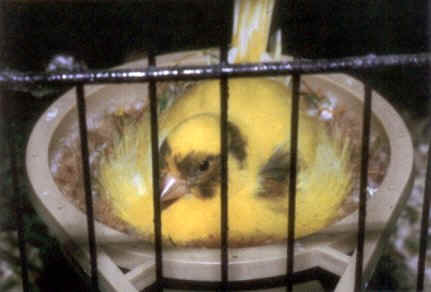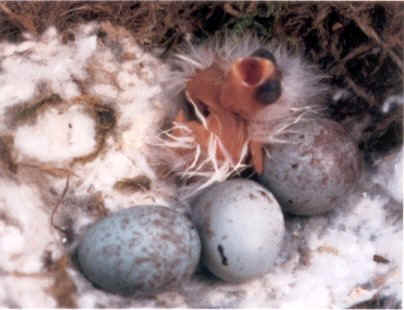
How To Achieve Top Breeding Birds

Breeding
By early March the cock Fifes should be in their single cages alongside the empty hensí cages. Hens in the meantime should be kept in their flight cages so that they can continue to exercise and come into higher breeding condition.
The cocks should now be singing lustily and appearing very active. Some cocks will even regurgitate soft food on to the wires or perches.
The Mating
If introduction has been gradual, as advocated, the cock bird will pull himself in when in the presence of the hen, pick up the piece of wood shaving and hop around before her with this potential nest material in his beak. If she does not respond by threatening him, the pair will not be far away from mating and a nest pan with a small amount of outer nesting material such as grass or moss can be introduced into the henís cage.
Many breeders these days introduce the nest pan along with nesting materials well before a cock is introduced. Once a hen appears to be building in earnest and pushing the material into place with her legs then she is ready to mate and the cock can be introduced. Mating usually takes place instantaneously.
As has already been mentioned, a hen squatting is an indication that she is ready to mate. A flighted cock will usually mate right away and the pair should then be separated. An unflighted cock may be wary of a hen in this position calling for a mate, and a little patience might be needed before a successful mating takes place.
Nesting
Hen Fifes in breeding condition will build a nest wherever they feel they can make a circular cup to hold the eggs. They will nest on the floor if they are not happy with their nest pans, particularly if wood shavings or newspaper are placed on the cage floor.
 Most
fanciers these days prefer the white plastic nest pan that fits on to the
front or side of the cage. Square wooden pans with a zinc gauze base are
also popular, as are earthenware pans with older fanciers. I prefer the
plastic pans and insert a felt lining, which is sewn or stuck with
carbolic soap to stop it moving around. A sprig of moss is dropped inside
for good measure to encourage the hen to start building.
Most
fanciers these days prefer the white plastic nest pan that fits on to the
front or side of the cage. Square wooden pans with a zinc gauze base are
also popular, as are earthenware pans with older fanciers. I prefer the
plastic pans and insert a felt lining, which is sewn or stuck with
carbolic soap to stop it moving around. A sprig of moss is dropped inside
for good measure to encourage the hen to start building.
Nesting directly onto the lining should not be encouraged. Soft nesting material in the form of moss raked from the lawn or bought from a nursery is ideal, dry soft grass is useful too. Other substances such as cotton wool and jute can then be offered in a wire holder to the hen when the nest is well underway.
It is important not to let the cock become involved with nest building. As the nest develops the hen will know when to call the cock, particularly when she is on the nest. Try to ensure that the cock is running with the hen on these occasions. Remove each egg as it is laid and replace it with a plastic dummy egg. If you do not see mating taking place, then wait and try again later that day.
Hatching
 |
Eggs should be removed and replaced by dummies until the fourth egg is laid. It is normal to set (place under the hen) the eggs on the morning the fourth egg is laid. Once there they should hatch after 13 to 14 days of incubation. Occasionally eggs will hatch after 12 Ĺ days. This is unusual but keep an eye on the cage just in case. A hen will tend to sit higher in the nest as the chicks are hatching. This is a better guide than looking for eggshells on the floor of the cage, as many hens eat the shells as soon as their chicks have hatched. Some eggs hatch up to 16 days old, so do not destroy prematurely. |
Summary
The golden rules for line breeding Fifes are:
-
Start with the best birds available. Several good pairs from one source will save you years of time and effort.
-
Only retain the best birds. A small stud of good birds is more enjoyable than a large stud of average ones.
-
Only breed from fit birds. Unfit birds will bring nothing but problems and will probably fail to reproduce.
-
Keep accurate records of parentage and qualities.
-
Double up on qualities wherever possible. Never double up on faults.
-
Even the best Fifes in the world will produce a proportion of average youngsters. These will possess qualities that might come out in future generations.
-
Never double Buff Fifes. Only double Yellow if there is no alternative or if one of the parents has very soft feathers.
-
Bring in an outcross only for a very specific reason, preferably a cock bird.
-
Create your own line of Fifes by line breeding and selective outcrossing. Some of the best studs are based on birds from two or more top lines.
-
When selecting your pairs or trios you must select birds with the correct type and quality. Try to get a good balance and select birds that can improve the faults in some of your other birds:
For example, if a good Yellow Cock has a poor forehead above the beak then try to remove this fault by running him with a broader feathered Buff Hen with a good skull.
![]()
Email:- terry@fifecanaries.com
(c) Terry Kelly & SL